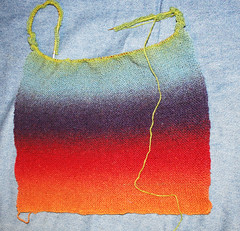
Like some of my blogging friends and acquaintances have been saying of late, “I gots nothin’” in the way of fascinating blog content for today. I am not burning with passion about a particular issue, and my knitting is fun but just getting bigger, that’s all. So, here are a few tidbits about things I’ve noticed or am interested in these days.
1. Yes, the Kauni Jacket is coming along just fine. I am about halfway up the right half of the back, heading toward the start of the right arm. The stripes are very wide, since there are only 64 stitches on that half. It’s a neat contrast to the thin stripes on the other side. I hope to get quite a bit done over the weekend. And maybe I’ll finish my socks, too. I just have an hour or two left on those socks. Just have to get motivated.
2. One motivation for finishing the socks is that I have the next pattern and yarn chosen. That’s the yarn in the picture--which was hard to locate, because I'd apparently forgotten to add it to my stash on Ravelry--and it's one of my most recent purchases, too! The pattern is called Charybdis. It is so cute, and I’m flattered that I actually inspired the designer to try her hand at designing! I think the yarn will look as good on the pattern as the yarn Fiona chose for her prototype. Heck, if she knitted a pattern I did, the least I can do is knit hers, right?
3. I even have another sock pattern to love. One of the ladies on the Texas knitting list I read posts patterns she finds, like every day. On Wednesday, this one, called Seriously Southwestern Socks, came up. I like it way more than some of the other two-color ones I’ve seen. I think I will try to find a suitable dark semi-solid, perhaps a very dark green, to make this with one of my many lighter colors of indie dyer sock yarns.
4. I’ve been reading a few of my magazines, and I enjoyed the latest Piecework, which came yesterday. If you are a fan of historical re-enactments, you really will want to get this issue. There are socks, a “vest” and a kind of shawl called a sontag, with authentic directions. I did find lots to like in the new Interweave Knits, too. Tonight I will look through it again to see if there’s anything in it I am just dying to make, so I can get yarn for it tomorrow. I’ll let you know if I choose a pattern.
5. Yep, tomorrow Deana, Dawn and I are going to head back out to Paige and Brenham. This time I will have a list of things I am looking for. Since there isn’t enough yarn for many large projects at my LYS, I hope to get a couple of projects’ worth of yarn. I’ve been carefully studying my queue on Ravelry, too.
And here’s a random blogger hint. I’ve noticed that on blogs with word verification, occasionally the word just doesn’t show up. Just type something random in and try to submit. Words will usually appear the next time. I do the verification of comments, because I was concerned at first that inappropriate things might get posted. I did get a spam comment last week, but it has not been as bad as I feared, not at all. I thank ALL of you who have commented lately, too. I learn a lot from you, and I feel better when I read your words of encouragement!




































